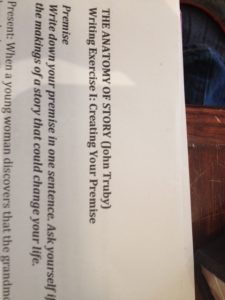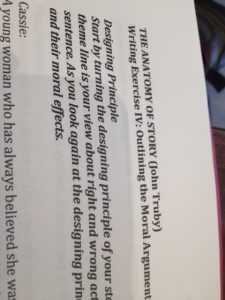This is part of the Bittersweet Book Launch case study, where Dan Blank and Miranda Beverly-Whittemore share the yearlong process of launching her novel. You can view all posts here.
By Miranda Beverly-Whittemore
 I’ll begin by saying that were I starting Truby for the first time, I’d go through the book right off the back and type up each worksheet (which he calls “Writing Exercises,” but I like to call worksheets since I’m a nerd). Then I’d “Save As” and rename each worksheet for the book I happen to be working on, since there’s a good chance I’d want to use this method in the future! I keep mine in a favorite notebook so I can reference them once I start writing in earnest (See? There it is- full of ideas I didn’t have before).
I’ll begin by saying that were I starting Truby for the first time, I’d go through the book right off the back and type up each worksheet (which he calls “Writing Exercises,” but I like to call worksheets since I’m a nerd). Then I’d “Save As” and rename each worksheet for the book I happen to be working on, since there’s a good chance I’d want to use this method in the future! I keep mine in a favorite notebook so I can reference them once I start writing in earnest (See? There it is- full of ideas I didn’t have before).
Chapter One: Story Space, Story Time
As I mentioned in yesterday’s post, I usually don’t work much with Chapter One (which outlines Truby’s beliefs). It’s definitely worth a read, though, because he says things like “a storyteller…is someone who plays.” It’s nice to be reminded that writing and creating a story can be pleasurable for both the reader and the writer, and I love that extra push to play.
Chapter Two: Premise
 Worksheet One, at the end of Chapter Two, is where Truby invites us to state what the book is about. As a literary novelist, this was a radical idea- so much of what I’d learned before I started working with Truby was all about denying that there is such a thing as a single truth of “aboutness” when it comes to writing fiction. There are surely many novelists who write brilliant, perfectly crafted books without thinking about this. But I’ve learned that I’m not one of them!
Worksheet One, at the end of Chapter Two, is where Truby invites us to state what the book is about. As a literary novelist, this was a radical idea- so much of what I’d learned before I started working with Truby was all about denying that there is such a thing as a single truth of “aboutness” when it comes to writing fiction. There are surely many novelists who write brilliant, perfectly crafted books without thinking about this. But I’ve learned that I’m not one of them!
Usually I come to Truby with an already clear sense of what I think the book will be about. Granted, my premise gets honed and revised as I work through the book, and so often looks different than what I started with. But I don’t go in blind; I just don’t feel ready to tackle this method until I already know at least a little about what I want to write about. However, Truby starts with the supposition that you might not know, and encourages you to dig deep, starting with the notion that you should “write something that may change your life.” That’s a good reminder too.
By the end of Worksheet One, you’ll have stated your premise, brainstormed some strong ideas about what will happen in your story, outlined the basic conflict, and gotten a good idea of you your main character will be.
Chapter Three: The Seven Key Steps of Story Structure
 Remember those 22 story steps I mentioned back in my first post? Think of the seven story steps you’ll explore in this chapter as the basic building blocks for those 22 steps. This is the chapter where you’ll start thinking more definitively about all that raw material you set down in Worksheet One, and how what you’ve already generated will shape itself into a natural story. Worksheet Two will help you do this, focusing in on your main character’s arc, from their weaknesses and needs at the beginning, to the new equilibrium of the universe at the end. You’ll start to think about aligning your main character’s arc with the arc of the story, so that they’ll be working together, instead of at cross purposes.
Remember those 22 story steps I mentioned back in my first post? Think of the seven story steps you’ll explore in this chapter as the basic building blocks for those 22 steps. This is the chapter where you’ll start thinking more definitively about all that raw material you set down in Worksheet One, and how what you’ve already generated will shape itself into a natural story. Worksheet Two will help you do this, focusing in on your main character’s arc, from their weaknesses and needs at the beginning, to the new equilibrium of the universe at the end. You’ll start to think about aligning your main character’s arc with the arc of the story, so that they’ll be working together, instead of at cross purposes.
Chapter Four: Character
 This is when it starts to get fun! In this chapter and then in Worksheet Three, you’ll get to know your protagonist much better. But you’ll do that by getting to know the other characters in the story too, including the antagonist (in my new novel, there’s more than one protagonist and more than one antagonist, so never fear if you don’t have such a black and white tale- the method can definitely be modified for your uses). You think about the Character Web, and how all the characters in your story can (and must) interact and illuminate each other.
This is when it starts to get fun! In this chapter and then in Worksheet Three, you’ll get to know your protagonist much better. But you’ll do that by getting to know the other characters in the story too, including the antagonist (in my new novel, there’s more than one protagonist and more than one antagonist, so never fear if you don’t have such a black and white tale- the method can definitely be modified for your uses). You think about the Character Web, and how all the characters in your story can (and must) interact and illuminate each other.
I love this part of the process because I almost always realize that a character I believed to be absolutely necessary when I first dreamed the book up is, in fact, not necessary at all, and there’s other ways to get across what I needed to without them. So this chapter always saves me a lot of time in the long run, because I’m forced to justify, in more than one way, who will live in my book.
Chapter Five: Moral Argument
 Truby presupposes that every tale is about a deeper moral system, and that, as he puts it on page 109, “you, as the author, are making a moral argument through what your characters do in the plot.” This is a good reminder that a novel is about many things. But he also loathes propaganda, and argues that only by letting your characters live honestly can your story resonate on deeper levels.
Truby presupposes that every tale is about a deeper moral system, and that, as he puts it on page 109, “you, as the author, are making a moral argument through what your characters do in the plot.” This is a good reminder that a novel is about many things. But he also loathes propaganda, and argues that only by letting your characters live honestly can your story resonate on deeper levels.
By the end of Worksheet Four, I always have a much deeper sense of the moral arc of my tale, and a sense of how all my characters will be woven into this moral arc as they live through the story themselves.
Tomorrow: Chapters 6-11
This post is part of a five part series. Click here for Part One, Part Two, Part Three, Part Four and Part Five.
